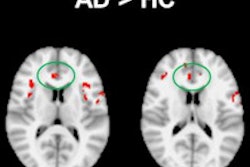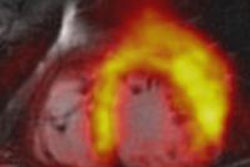Using less-complex MRI scans to triage patients with hearing loss, while reserving comprehensive MRI exams for those with pathology, can save money without affecting diagnostic efficacy, according to research published in the January issue of the American Journal of Roentgenology.
The two-tiered protocol allows patients to spend less time in the MRI scanner, avoid the discomfort of intravenous contrast injection, and possibly pay less money for the procedure, depending on the co-payment, the researchers found. In addition, imaging facilities could achieve greater throughput than with a conventional MRI protocol.
Under the two-tiered approach, a patient initially would have his or her internal auditory canals imaged with high-resolution 3D T2-weighted MRI. Then, if a follow-up scan is warranted, the patient would receive a more comprehensive MRI exam.
Cost-effectiveness
MRI can be a costly modality, especially for people with sensorineural hearing loss. These individuals often undergo lengthy MR exams of the brain and internal auditory canals to rule out a diagnosis of vestibular schwannoma, a rare but clinically significant condition, wrote Dr. Aseem Sharma, from the Mallinckrodt Institute of Radiology, and colleagues (AJR, January 2014, Vol. 202:1, pp. 136-144).
Typically, a comprehensive MRI exam can include multiple parameters and sequences, with and without contrast. A limited unenhanced T2-weighted MRI scan has been explored as an alternative, but there is little research on the use of the two techniques together, with the limited scan helping to triage patients who would then get the more comprehensive study.
Sharma and colleagues retrospectively identified consecutive patients between November 2009 and July 2011 who had undergone MRI of the brain and internal auditory canals due to sensorineural hearing loss. The study cohort included 256 patients (122 men and 134 women) who ranged in age from 20 to 88 years (mean age, 54.8 years ± 12.2).
MRI protocol
Patients first received high-resolution 3D T2-weighted imaging, and images were interpreted by three readers who decided whether cases were positive (i.e., disease was present). For these patients, a comprehensive exam was ordered.
The comprehensive MRI scan included 3-mm axial and coronal T1-weighted imaging across the internal auditory canals before and after contrast administration, 2-mm axial T2-weighted imaging, and high-resolution 3D T2-weighted imaging with a submillimeter slice thickness, the authors wrote. Many patients also underwent a comprehensive MRI exam of the brain.
Of the 256 patients, 40 had evidence of issues that could pertain to hearing loss, including presumed vestibular schwannoma (32, 80%), otomastoiditis (3, 7.5%), and dilated endolymphatic ducts (1, 2.5%). The conventional approach of initially performing comprehensive MRI achieved sensitivity of 95% and specificity of 99%, while the two-tiered approach had sensitivity of 87% and specificity of 100%.
To estimate costs related to the two approaches, the researchers used 2012 reimbursement rates from the U.S. Centers for Medicare and Medicaid Services (CMS) for MRI of the brain with and without contrast.
"Because there are no current models available for the reimbursement of the two-tiered approach, we assumed that the technical component of the initial abbreviated study ... will be reimbursed at a level 50% relative to the corresponding 2012 CMS reimbursement rate for MRI of the brain without contrast material," they wrote.
The conventional approach was found to be less cost-effective, with a baseline incremental cost-effectiveness ratio (ICER) of 27,299 minutes of scanner utilization per unit increase in effectiveness. Assuming a 50% reduction in CMS reimbursement, this would result in an ICER of $258,664 per unit increase in effectiveness.
"Our results make a strong case for limiting the initial assessment of patients with hearing loss to be evaluated using only 3D T2-weighted imaging," Sharma and colleagues wrote. "If the two-tiered approach were adopted, patients would benefit from having to spend significantly less time inside the scanner and avoiding the discomfort of IV contrast injection in many instances."
Patients with a health insurance co-payment could benefit from reduced costs related to imaging exams, in part because they may not need to return for follow-up scans.
"With proper guidance, patient anxiety can be avoided by explaining the plan of action ahead of time to the patients," the authors added. "The relatively few callbacks with this system do not significantly detract from the efficiency of the strategy."
As for imaging facilities, decreased revenue per patient for the two-tiered approach could be offset by a reduction in scanner utilization time.
"With a significantly decreased cost per patient of 8.8 minutes in the two-tiered approach in comparison with 37 minutes with the conventional approach, a higher throughput can be achieved at the scanner," Sharma and colleagues wrote.


.fFmgij6Hin.png?auto=compress%2Cformat&fit=crop&h=100&q=70&w=100)





.fFmgij6Hin.png?auto=compress%2Cformat&fit=crop&h=167&q=70&w=250)











